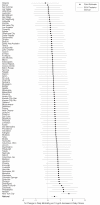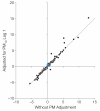Ozone and short-term mortality in 95 US urban communities, 1987-2000
- PMID: 15547165
- PMCID: PMC3546819
- DOI: 10.1001/jama.292.19.2372
Ozone and short-term mortality in 95 US urban communities, 1987-2000
Abstract
Context: Ozone has been associated with various adverse health effects, including increased rates of hospital admissions and exacerbation of respiratory illnesses. Although numerous time-series studies have estimated associations between day-to-day variation in ozone levels and mortality counts, results have been inconclusive.
Objective: To investigate whether short-term (daily and weekly) exposure to ambient ozone is associated with mortality in the United States.
Design and setting: Using analytical methods and databases developed for the National Morbidity, Mortality, and Air Pollution Study, we estimated a national average relative rate of mortality associated with short-term exposure to ambient ozone for 95 large US urban communities from 1987-2000. We used distributed-lag models for estimating community-specific relative rates of mortality adjusted for time-varying confounders (particulate matter, weather, seasonality, and long-term trends) and hierarchical models for combining relative rates across communities to estimate a national average relative rate, taking into account spatial heterogeneity.
Main outcome measure: Daily counts of total non-injury-related mortality and cardiovascular and respiratory mortality in 95 large US communities during a 14-year period.
Results: A 10-ppb increase in the previous week's ozone was associated with a 0.52% increase in daily mortality (95% posterior interval [PI], 0.27%-0.77%) and a 0.64% increase in cardiovascular and respiratory mortality (95% PI, 0.31%-0.98%). Effect estimates for aggregate ozone during the previous week were larger than for models considering only a single day's exposure. Results were robust to adjustment for particulate matter, weather, seasonality, and long-term trends.
Conclusions: These results indicate a statistically significant association between short-term changes in ozone and mortality on average for 95 large US urban communities, which include about 40% of the total US population. The findings indicate that this widespread pollutant adversely affects public health.
Figures



References
-
- US Environmental Protection Agency . Latest Findings on National Air Quality: 2002 Status and Trends. EPA Office of Air Quality Planning and Standards, Emissions, Monitoring, and Analysis Division; Research Triangle Park, NC: 2003. EPA 454/K-03-001.
-
- US Environmental Protection Agency [Accessed October 22, 2004];Green book nonattainment areas for criteria pollutants. Available at: http://www.epa.gov/oar/oaqps/greenbk/
-
- Haagen-Smit AJ. Chemistry and physiology of Los Angeles smog. Indust Eng Chem. 1952;44:1342–1346.
-
- Dockery DW. Pope CA III. Acute respiratory effects of particulate air pollution. Annu Rev Public Health. 1994;15:107–132. - PubMed
-
- Lippmann M. Health effects of tropospheric ozone: review of recent research findings and their implications to ambient air quality standards. J Expo Anal Environ Epidemiol. 1993;3:103–129. - PubMed
Publication types
MeSH terms
Substances
Grants and funding
LinkOut - more resources
Full Text Sources
Medical
Research Materials
Miscellaneous

